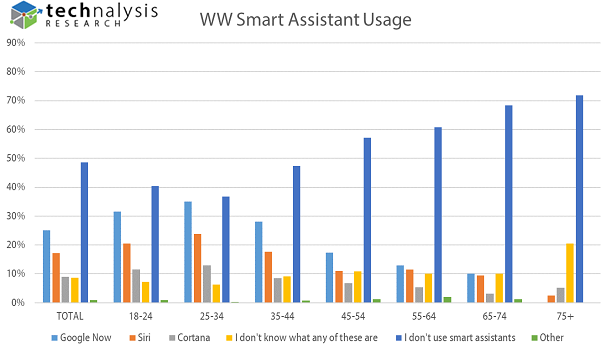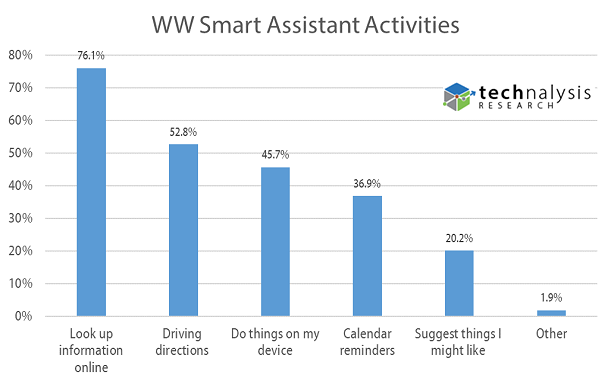| |
November 24, 2015
Consumer Device Purchase Trends
November 17, 2015
Screenless Wearables and New Means of Interaction
November 10, 2015
The Technological Magic of Autodiscovery
November 3, 2015
IOT's Biggest Impact? Business Models
October 26, 2015
Mobility Isn’t Just a Technology, It’s a Mindset
October 20, 2015
The Arrogance of Tech
October 13, 2015
The Tech World Moves to AND, Away from OR
October 6, 2015
Reimagining Personal Computers
September 29, 2015
The Rebirth of Virtual Clients
September 23, 2015
What's Next for Consumer Tech?
September 15, 2015
The Key to IOT Security
September 9, 2015
Home Gateways: Extinction or Evolution?
September 1, 2015
The Real Software Revolution? It’s in the Data Center
August 25, 2015
Is The Tech Market Hitting Middle Age?
August 18, 2015
Building Vertical Platforms for IOT
August 4, 2015
The IOT Monetization Problem
July 28, 2015
The Windows 10 Hardware Argument
July 21, 2015
The Complexity Challenge Drives Shadow IT
July 14, 2015
The Hidden Opportunity of Corporate Smartphones
July 7, 2015
The Analytics of IOT
June 30, 2015
IOT Momentum Starting to Build
June 23, 2015
Breaking the IOT Connection
June 16, 2015
Software is a Service
June 9, 2015
The Challenge of Rising Expectations
June 4, 2015
Insider Extra: Rethinking the Conference Room
June 2, 2015
Win10 + Intel Skylake + Thunderbolt 3 = Interesting PC
May 26, 2015
The IOT Opportunity is Wide Open
May 21, 2015
Insider Extra: The Carrier Challenge for Consumer IOT
May 19, 2015
Maker Movement Drives the Future
May 14, 2015
Insider Extra: The Next Step for Wearables: Health Care
May 12, 2015
Making Sense of IOT
May 5, 2015
A Fresh Look at Wearables
April 30, 2015
Insider Extra: The Amazing HoloLens Leap
April 28, 2015
The Device Dream Team: Large Smartphones and Thin Notebooks
April 23, 2015
Insider Extra: Mobile Sites Should Be Dead
April 21, 2015
Wearables + Connected Cars = IOT Heaven
April 14, 2015
The Future of Wearable Power Is Energy Harvesting
April 7, 2015
Twinning Is Key to Connected Devices
April 2, 2015
Insider Extra: Competing Standard Co-Existence For Wireless Charging and IOT
March 31, 2015
Riding the High-Res Tidal Wave
March 24, 2015
Smart Cars Accelerating Slowly
March 19, 2015
Insider Extra: The Future of Computing is Invisible
March 17, 2015
Smart Home Decade Dilemma
March 10, 2015
Apple Event Surprises
March 3, 2015
Flat Slab Finale?
February 26, 2015
Insider Extra: "Phablet" Impact Continues to Grow
February 24, 2015
Paying for Digital Privacy
February 19, 2015
Insider Extra: The Wire-Free PC
February 17, 2015
Whither Apple?
February 12, 2015
Insider Extra: The Real IOT Opportunity? Industry
February 10, 2015
Business Models For The Internet of Things (IOT)
February 5, 2015
Insider Extra: Is "Mobile Only" The Future?
February 3, 2015
Sexiest New Devices? PCs...
January 29, 2015
Insider Extra: iPhone Next
January 27, 2015
How Will Windows 10 Impact PCs and Tablets?
January 22, 2015
Insider Extra: Hands-On (or Heads-on) With HoloLens
January 20, 2015
Whither Windows 10?
January 15, 2015
Insider Extra: Mobile Security: The Key to a Successful BYOD Implementation
January 13, 2015
Smart Home Situation Likely To Get Worse Before It Gets Better
January 6, 2015
More Tech Predictions for 2015
December 30, 2014
Top 5 Tech Predictions for 2015
|
|
|














 |
December 1, 2015
By Bob O'Donnell
When Adele sings “Hello,” people are clearly listening—to the record-setting tune of over 3.3 million album purchases in a single week. When you greet your smart device with a verbal introduction, however, well, let’s just say the results aren’t quite as clear.
Though they were hailed as “The Next Big Thing” when they were first introduced, Smart Assistants, or Personal Assistants, such as Siri, Google Now, and Cortana, haven’t exactly torn up the charts. Yes, there was a big initial splash—especially after the initial release of Siri on the iPhone 4S in October 2011—but there has been an equivalent, if not even larger, backlash since then. In fact, Siri quickly devolved from something people marveled at to something people joked about.
To be fair, Apple has made significant improvements to Siri since then, and the introduction of both Google Now and Microsoft’s Cortana has raised the bar for the Smart Assistants category as a whole.
In order to get a better sense of where things stand now, I included a few questions on the recent TECHnalysis Research Consumer Device Usage study of 3,012 people across five countries (US, UK, Germany, Brazil and China) to find out who may be using these verbal assistance-based capabilities, what they’re using them for, and what they think about them overall.
The results show that while Smart Assistants are making progress, they still have a long way to go before they really become mainstream tools, particularly with older consumers. The chart below shows which age groups are using which Smart Assistants, and which use none at all.

©2015, TECHnalysis Research LLC
While there are a number of very interesting points that can be gleaned from this chart, the first thing that stands out is that nearly half of all respondents across all age groups (Total) said they don’t use Smart Assistants at all, and another 9% don’t know what any of the Smart/Personal Assistants actually are. Amongst the 1,024 US respondents, the result was just over 50% saying they don’t use Smart Assistants and 7% who don’t know what they are. (Note that the totals add up to more than 100% because respondents could select all the Smart Assistants they use, with the average number they use being 1.2.) So, for both worldwide (WW) and the US, only 43% of device-owning consumers said they use Smart Assistants. Clearly, this suggests that more work needs to be done to make these voice-based capabilities more compelling (and, likely, more accurate) before a much wider audience will actually use them.
Breaking the results down by age group, only in the 18-24 and 25-34 age groups are there more people who use Smart Assistants than don’t (in the US results, only 25-34s). Also, there is actually a smaller percentage of 18-24-year old Millennials using Smart Assistants than 25-34-year old Gen X’ers (47% vs. 62% in the US and 52% vs. 57% worldwide). These somewhat surprising numbers suggest that younger device users are not necessarily the most proactive when it comes to using the latest features, or that voice-based control isn’t as interesting, or necessary, for younger users as it is for slightly older users (or, most likely, some combination of these two possibilities). Regardless, it reflects a subtle, but potentially important shift about the expectations that future generations of device owners may have.
Interestingly, the activities for which Smart Assistants were used (by the 43% who used them) was actually very similar across age groups, both worldwide and in the US. The chart below shows the top-level results for the full five-country sample of 1,286 Smart Assistant users.

©2015, TECHnalysis Research LLC
The top activity by far was requests for information searches, followed by asking for directions. (One difference in the US results is that over 59% of US respondents asked for driving directions, versus just under 53% worldwide). Asking to do certain activities on the device, such as play music, launch apps, adjust settings, etc., was done by fewer than half of Smart Assistant users. Truly “smart” activities, such as using a Smart Assistant to make suggestions of other things, music, restaurants, etc., were only done by 1 in 5 Smart Assistant users.
Of course, the other big data point from the first chart was the dominance of Google Now usage over other Smart Assistants, particularly among younger users. It turns out Google Now also edged out both Cortana and Siri on an overall satisfaction rating as well, but just barely, with an average of 3.8 (on a scale of 5), versus 3.7 for Cortana, and 3.6 for Siri. In the US, Google Now and Cortana were statistically tied at 3.9, while Siri had a 3.5.
The notion of a voice-based interface, and the concept of talking at your devices was more science fiction than science fact for a very long time, so the fact that we’re making any progress in this challenging area is unquestionably a good thing. Still, expectations continue to be very (and probably unrealistically) high for these technologies, so it is a bit disappointing to see how few people are using Smart Assistants. It’s also frustrating to see how little they’re being used for truly smart activities—the most common usages are arguably little more than simple typing replacement.
There’s no question that truly Smart Assistants will be a critical part of future devices and services we use, but it’s also increasingly clear that we still have a long way to go before we reach that digital nirvana.
Here's a link to the original column: https://techpinions.com/smart-assistants-making-progressbut-slowly/42528
Podcasts
Leveraging more than 10 years of award-winning, professional radio experience, TECHnalysis Research participates in a video-based podcast called Everything Technology.
LEARN MORE |
|
Research Offerings
TECHnalysis Research offers a wide range of research deliverables that you can read about here.
READ MORE |
|









